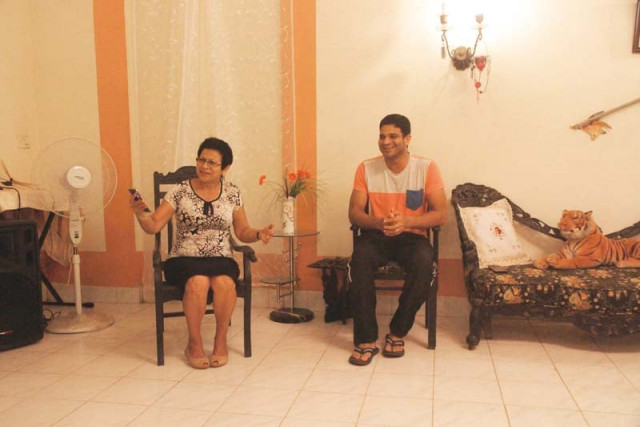Goa: In the shadow of the past
Home to beautiful beaches, Goa’s colonial history weighs heavily on its ethos

Maria Helena Souza and her son Lloyd Souza sit in their 400-year-old hous. PHOTOS : ATHAR KHAN
 Joseph Sequeira is the deputy punch of Calangut’s Village Panchayat and the owner of Casa Severina Hotel. PHOTO: ATHAR KHAN
Joseph Sequeira is the deputy punch of Calangut’s Village Panchayat and the owner of Casa Severina Hotel. PHOTO: ATHAR KHAN A view of the Casa Severina Hotel. PHOTO : ATHAR KHAN
A view of the Casa Severina Hotel. PHOTO : ATHAR KHANLloyd and his wife Nadia are doctors by profession and they live in the Calangute area of the provincial capital of Panjim. These days, the couple is working hard to earn a name as good dancers. “We rehearse every day at home when we get done with our work,” Lloyd explains. “We are participating in the international ballroom dance competition starting next week in India.”
On a humid monsoon evening, Souza’s mother, Maria Helene Souza, welcomes us into her traditionally decorated home. “This house is 400-years-old and is built in traditional Portuguese style,” Helene explains. Black and white portraits of her parents, grandparents, great-grandparents and great-great grandparents hang on the walls. Five generations have lived under this roof, surrounded by well-maintained green lawns and fortified by small boundary walls. “My grandson is the sixth generation living in this house,” the 86-year-old professor, who retired two years ago, proudly says. And even at her age, Helene shares her son’s love for dance.
Goa remained one of the colonies of the Empire of Portugal for 500 years, resulting in the conversion of the many indigenous Hindus to Christianity. Marriages between the Portuguese and locals further cemented the coloniser’s deep cultural influence in the coastal region. This cultural mix is visible even today in almost every house. “Portuguese culture is so ingrained in our society that we live the way they used to,” Maria says. “Today, Goa is part of India, but culturally it still remains Portuguese.”
 In Goa’s heart, Panaji. PHOTO : ATHAR KHAN
In Goa’s heart, Panaji. PHOTO : ATHAR KHAN DJ Lui Fernandes, 45, playing music at Baga Beach, one of the world’s most beautiful places for beach parties. PHOTO : ATHAR KHAN
DJ Lui Fernandes, 45, playing music at Baga Beach, one of the world’s most beautiful places for beach parties. PHOTO : ATHAR KHANThe evenings in Goa are pleasant, as the cool sea breeze passes tall coconut and sprawling cashew trees. Buildings here are painted bright colours and young men and women wearing shorts and loose T-shirts stand next to gleaming motorbikes that are rented out to tourists. “Goa is very peaceful, with hardly any crime,” Helene says, explaining that the region has a 100% literacy rate.
Panjim became Goa’s provincial capital after an epidemic killed thousands in Old Goa in the 17th Century. It has since become the busiest tourist place here, with attractions including the 16th Century St. Xavier Francis Church, the Spices Garden and so on.
Christians, who largely adopted Portuguese culture and religion, form up to 29% of Goa’s population of 1.817 million, according to the 2012 statistics.
Joseph Sequeira, the deputy panch of the Calangute Village Panchayat, is one of many Christian hotel-owners here. “Life had never been so easy on this land,” he says, sipping coffee in Casa Severina, a hotel named after his grandmother. “I used to go to school barefoot and my sisters were maids for a Parsi family.”
The 50-year-old hotel-owner began his career in the services industry as a trainee waiter soon after he obtained a senior secondary school certificate 30 years ago. Today, his assets are worth INR40 million. His only son is a manager at one of the country’s best hotels — the Taj Mahal.
 A mobile tea stall on a bicycle at Baga Beach. PHOTOS : ATHAR KHAN
A mobile tea stall on a bicycle at Baga Beach. PHOTOS : ATHAR KHANUnder the Portuguese occupation, hundreds of thousands of Goans migrated worldwide in search of greener pastures, as the coastal province largely remained underdeveloped. A small community of Goans made their home in Karachi — another colony under the British Empire. However, long after the days of empires, the Goans of Pakistan and India don’t have much in common, as visa restrictions remain strict between the two countries. “My father used to visit Africa and he would always try to dock at Karachi because he liked it so much,” Helene recalls. “We have never been to Pakistan because none of our relatives live there. But, we have never tried either because of the visa restrictions.”

The writer is a staff correspondent who visited India as part of a journalism exchange program organised by the East West Center.
He tweets @NaeemSahoutara
Published in The Express Tribune, Sunday Magazine, November 8th, 2015.



















COMMENTS
Comments are moderated and generally will be posted if they are on-topic and not abusive.
For more information, please see our Comments FAQ